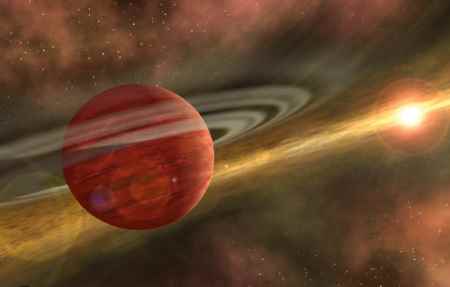Astronomers have discovered about 4,200 confirmed exoplanets and many more candidates since the early days of exoplanet discovery. And with those kinds of numbers, a few odd planets—ones that scientists could not imagine only a few decades ago—are bound to exist. Here are some of the universe's oddest planets that are top contenders for the title.
The water world, GJ 1214 b, as imagined by an artist.
GJ 1214 b, a super-Earth roughly three times the size of our own planet and seven times its mass, is around 40 light-years away from Earth. This bizarre planet, with an estimated temperature of roughly 450° Fahrenheit (230° Celsius), orbits its red dwarf star once every 38 hours.However, it's not just the warm temperature that makes it unusual. GJ 1214 b is essentially a giant water world enclosed in a thick, steamy atmosphere, according to a 2012 research based on Hubble Space Telescope data.
In a press release, research author Zachory Berta, who was then at the Harvard-Smithsonian Center for Astrophysics, stated that GJ 1214b is unlike any other planet that is now known to us. Water makes up a significant portion of its mass. 'The extreme temperatures and high pressures would yield unique materials like 'hot ice' or superfluid water,' substances that are completely foreign to our everyday experience, making it one of the strangest planets in the cosmos,' he concluded.
Neptune
A totally bizarre configuration was uncovered by astronomers in 2019: a Neptune-sized planet orbiting an Earth-sized star. However, the star in issue, a tiny white dwarf known as WDJ0914+1914, is no longer very bright. Instead, it resembles a stellar corpse. To prevent gravitational collapse, it no longer internally fuses materials. Its temperature, which is around 49,500 degrees Fahrenheit, is more comparable to a highly compressed, smouldering ember (25,000 Celsius). And that heat is sufficient to gradually evaporate the neighbouring planet.
The University of Warwick's Boris Gänsicke, who led the investigation, declared in a press statement at the time, 'This star has a planet that we can't see directly.'
jupiter
Iron pours during the night on the strange hot Jupiter WASP-76 b. But this planet is just as horrible during the daytime. It can get extremely hot there, reaching temperatures of up to 4,300 degrees Fahrenheit (2,400 degrees Celsius), hot enough to melt metal.With a distance of 640 light-years from Earth and a size slightly smaller than Jupiter, WASP-76 b has terrible weather because of its incredibly eccentric orbit.
Gas giant planets like WASP-76 b are known as hot Jupiters because of how closely they orbit their star(s) — in this case, over ten times closer than Mercury is to our Sun. Because of this proximity, WASP-76 b is 'tidally bound' to its star, with one side trapped in perpetual darkness and the other permanently baking in light.
a robust magnetic field-producing exoplanet.
In the Milky Way, only 20 light-years from the Sun, a strange renegade planet without a star wanders. Additionally, this odd, migratory world has a magnetic field that is 4 million times more potent than Earth's, according to a 2018 study that was published in The Astrophysical Journal. Unexpectedly, the exoplanet also appears to produce magnificent auroras that would surpass our own northern lights, making it one of the strangest words in the universe.
The strange, untethered item, which has the short name SIMP J01365663+0933473, was initially seen back in 2016. Simp was once assumed to be a brown dwarf, which is an object that is neither large enough to be a planet nor small enough to be a star.
Earth
This unquestionably strange planet is noteworthy not just for its habitable features, which include an abundance of water, comfortable temperatures and pressures, and a magnetic bubble that shields the planet. Additionally, the universe's most intelligent life is found on Earth! The oddest planet we are aware of, Earth is the only spot in the universe where we are confident can host life.
That's because Earth is more complex than simply a spherical mass of inert matter that changes over time as a result of geological processes and other cosmic forces. Our planet is home to animals and vegetation that, for better or worse, physically alter the appearance of the earth.




Leave Comment